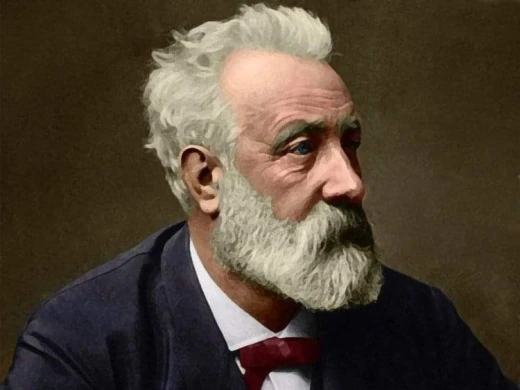
Jules Verne, the prolific French author of the 19th century, holds a revered place in the annals of literature as a pioneer of science fiction and adventure. His imaginative tales of exploration, discovery, and technological innovation have captivated readers for generations, inspiring wonder and sparking the imagination of audiences worldwide. From his early inspirations to his enduring legacy, Verne’s life and works are a testament to the power of storytelling to transcend time and space, inviting readers on extraordinary journeys to the farthest reaches of the imagination. Join us as we delve into the fascinating world of Jules Verne, where adventure knows no bounds and the possibilities of the future are limited only by the depths of the human imagination.
Early Inspiration (Age 6): At the age of six, Jules Verne was sent to boarding school, an experience that profoundly influenced his future literary endeavors. It was during this time that he encountered his teacher, the widow of a shipwrecked captain, who regaled him with captivating tales of the sea and daring adventures. This exposure sparked a fascination with maritime exploration and laid the foundation for Verne’s later works, where the theme of adventure and exploration would feature prominently. The vivid stories told by his teacher ignited Verne’s imagination and instilled in him a lifelong passion for storytelling, particularly in the realm of maritime adventure.
Law Degree, Literary Dreams (1851): Despite familial pressure to pursue a career in law, Jules Verne followed his literary aspirations alongside his legal studies. In 1851, he earned his law degree from the University of Paris and embarked on a journey that would ultimately blend his professional training with his creative passions. Verne’s time at university allowed him to refine his writing skills while also acquiring the knowledge and discipline necessary for legal practice. Though he complied with his father’s wishes by attaining his degree, Verne’s heart remained devoted to literature, and he continued to explore various literary forms, including plays and short stories.
Stock Market by Day, Sci-Fi by Night (1857): Balancing his career as a stockbroker with his burgeoning writing ambitions, Jules Verne found himself navigating the realms of finance by day and the realms of imagination by night. Despite the demands of his professional life, Verne remained steadfast in his dedication to crafting stories that stretched the boundaries of human imagination. It was during this period that he encountered his breakthrough moment when he found a publisher willing to embrace his innovative ideas and champion his foray into science fiction literature. This dual existence, where the practicalities of financial markets coexisted with the limitless possibilities of the creative mind, undoubtedly shaped Verne’s unique perspective as a writer.
“Voyages Extraordinaires” Series Launched (1863): In 1863, Jules Verne embarked on a literary odyssey that would captivate readers for generations to come with the launch of his groundbreaking series, “Voyages Extraordinaires” (Extraordinary Journeys). This seminal moment marked the beginning of Verne’s prolific exploration of speculative fiction, where he transported readers to far-flung corners of the globe and beyond, igniting their imaginations with tales of adventure and scientific wonder. With “Five Weeks in a Balloon” as its inaugural installment, the “Voyages Extraordinaires” series would come to define Verne’s literary legacy, showcasing his unparalleled ability to blend scientific realism with thrilling narratives.
Accuracy Amidst the Adventure: Jules Verne’s meticulous research and attention to detail distinguished him as a pioneer of scientific speculation in literature. His insatiable curiosity and dedication to accuracy often resulted in surprisingly prescient predictions of future technologies, ranging from submarines and helicopters to communication networks. Verne’s commitment to scientific realism not only lent credibility to his narratives but also inspired readers to contemplate the possibilities of technological advancement. His ability to seamlessly integrate scientific concepts into captivating adventure stories set a new standard for speculative fiction, earning him a reputation as a visionary author ahead of his time.
Record-Breaking Streak: Between 1863 and 1905, Jules Verne embarked on an unparalleled literary journey, producing an astonishing body of work that encompassed over 60 novels. With an unmatched pace of creativity, Verne churned out an average of nearly two novels per year, showcasing his prodigious storytelling abilities and boundless imagination. This remarkable output not only solidified Verne’s status as one of the most prolific authors of his era but also ensured his enduring legacy in the annals of literature. His relentless dedication to his craft enabled him to explore a myriad of themes and genres, captivating readers with each new literary endeavor.
Journey to the Center of Popularity (1864): “Journey to the Center of the Earth,” published in 1864, catapulted Jules Verne to international acclaim and established him as a master of science fiction adventure. The novel, which follows the daring expedition of Professor Otto Lidenbrock and his companions into the depths of the Earth’s interior, captured the imaginations of readers with its exhilarating blend of scientific speculation and high-stakes adventure. Verne’s vivid descriptions of subterranean landscapes and encounters with prehistoric creatures enthralled audiences and cemented the novel’s status as a timeless classic. “Journey to the Center of the Earth” remains one of Verne’s most beloved works, continuing to captivate readers with its sense of wonder and exploration.
Underwater Exploration Before the Sub (1870): “Twenty Thousand Leagues Under the Sea,” published in 1870, emerged as another iconic work in Jules Verne’s literary repertoire, captivating audiences with its imaginative portrayal of underwater exploration. The novel chronicles the extraordinary adventures of Professor Pierre Aronnax, his loyal servant Conseil, and harpooner Ned Land aboard the enigmatic submarine, the Nautilus, commanded by the enigmatic Captain Nemo. Verne’s meticulous attention to detail and vivid descriptions of marine life and underwater landscapes transported readers to a realm of unparalleled wonder and discovery. “Twenty Thousand Leagues Under the Sea” not only showcased Verne’s visionary storytelling but also sparked widespread fascination with the mysteries of the deep sea and the possibilities of underwater exploration.
Around the World in 80… Pages? (1872): “Around the World in Eighty Days,” published in 1872, emerged as another triumph for Jules Verne, capturing the imagination of readers with its exhilarating race against time. The novel follows the adventures of the eccentric English gentleman Phileas Fogg and his loyal valet Passepartout as they embark on a daring journey to circumnavigate the globe in just eighty days. Verne’s masterful storytelling and keen sense of adventure propelled readers across continents and oceans, encountering a myriad of obstacles and unexpected twists along the way. “Around the World in Eighty Days” not only captivated audiences with its thrilling narrative but also inspired real-life attempts to replicate Fogg’s fictional journey, further solidifying its status as a literary classic.
More Than Just Sci-Fi: While Jules Verne is best known for his contributions to science fiction literature, his literary repertoire extends far beyond the confines of speculative fiction. Throughout his career, Verne explored a diverse range of genres, including historical fiction, adventure stories, and social commentary, showcasing his versatility as a writer. From tales of maritime exploration to riveting adventures set in exotic locales, Verne’s body of work reflects his insatiable curiosity about the world and its myriad wonders. His ability to seamlessly blend elements of science fiction with other genres enabled him to captivate readers of all ages and backgrounds, ensuring his enduring relevance in the literary landscape.
Inspiration for Generations: Jules Verne’s influence extended far beyond his lifetime, inspiring generations of writers who followed in his footsteps. Esteemed authors such as H.G. Wells, Ray Bradbury, and Isaac Asimov credited Verne as a major influence on their own works, acknowledging his pioneering contributions to the genre of science fiction. Verne’s imaginative storytelling and visionary themes continue to resonate with contemporary writers, shaping the trajectory of speculative fiction and fostering a legacy that spans across centuries.
Verne’s Visionary Voyages: Throughout his literary career, Jules Verne’s novels were characterized by themes of technological advancement, space travel, and exploration. From fantastical journeys to the depths of the ocean to daring expeditions to the far reaches of outer space, Verne’s visionary tales inspired readers to dream of the possibilities of the future. His uncanny ability to anticipate technological innovations and scientific discoveries captured the imaginations of readers worldwide, fueling their curiosity about the mysteries of the universe and humanity’s potential for exploration and discovery.
French Literary Icon: Jules Verne occupies a prominent place in French literary history, earning recognition as one of the most translated authors in the world. His works have been translated into over 150 languages, a testament to the universal appeal of his storytelling and the enduring popularity of his literary creations. Verne’s status as a French literary icon is further underscored by his cultural significance and lasting impact on literature, making him a beloved figure in the pantheon of literary greats.
Beyond Earthly Bounds: Jules Verne’s literary explorations extended beyond the confines of Earth, encompassing speculative journeys to the moon and beyond. In novels such as “From the Earth to the Moon” and “Around the Moon,” Verne envisioned ambitious expeditions into outer space, capturing the imagination of readers with his imaginative portrayals of lunar exploration. His visionary depictions of space travel not only entertained audiences but also inspired scientific advancements and fueled humanity’s collective fascination with the cosmos.
Airborne Adventures: Jules Verne’s fascination with early aviation is evident in several of his novels, where he depicted exhilarating adventures aboard hot air balloons and futuristic flying machines. Works such as “Five Weeks in a Balloon” and “Robur the Conqueror” showcase Verne’s keen interest in the possibilities of aerial exploration and his ability to weave thrilling narratives around airborne adventures. His imaginative depictions of flight paved the way for future generations of writers and innovators, inspiring dreams of soaring through the skies and exploring new frontiers.
Mysterious Island Inspiration: The mysterious island setting featured in Jules Verne’s novel “The Mysterious Island” is believed to have been inspired by Lively Island, a volcanic island near Sicily. Verne’s vivid descriptions of the island’s rugged terrain and natural wonders captured the imaginations of readers, transporting them to a remote and enigmatic locale where adventure and discovery awaited. The real-life inspiration behind Verne’s fictional island adds an intriguing layer of authenticity to the novel, further enhancing its appeal to readers fascinated by tales of exploration and adventure.
Verne’s Brush with Disaster: In 1886, Jules Verne experienced a harrowing ordeal when his mentally ill nephew shot him in the leg, resulting in a permanent limp that would impact his writing output in later years. The incident, though tragic, serves as a testament to Verne’s resilience in the face of adversity and underscores the challenges he faced both personally and professionally. Despite the physical and emotional toll of his injuries, Verne continued to pursue his literary aspirations, leaving an indelible mark on the world of literature despite the obstacles he encountered along the way.
French Academy Rejection: Despite his immense popularity and literary acclaim, Jules Verne was never elected to the prestigious Académie française, a recognition that eluded him throughout his lifetime. The oversight is often attributed to Verne’s perceived status as a popular rather than highbrow author, as well as his unconventional writing style and subject matter. Nevertheless, Verne’s omission from the Académie française did little to diminish his stature as one of the most celebrated and influential authors of his time, leaving a lasting legacy that transcends institutional recognition.
Posthumous Publication: Jules Verne continued to write prolifically until his death in 1905, leaving behind a legacy of unfinished manuscripts that would be published posthumously. Works such as “Paris in the Twentieth Century,” written in 1863 but not published until 1994, offer fascinating insights into Verne’s vision of the future and his reflections on contemporary society. These posthumously published works serve as a testament to Verne’s enduring creativity and literary prowess, allowing readers to further explore the depths of his imagination long after his passing.
Enduring Legacy: Jules Verne’s literary works continue to captivate audiences worldwide, with adaptations into film, television, and theatrical productions ensuring his stories remain relevant for new generations of readers and viewers. From classic adaptations of his most beloved novels to modern reinterpretations that reimagine his timeless tales for contemporary audiences, Verne’s influence pervades popular culture in myriad forms. His enduring legacy as a pioneer of science fiction literature and a masterful storyteller ensures that his contributions to the world of literature will continue to be celebrated and cherished for years to come.
Jules Verne Day: French literary circles commemorate Jules Verne Day on February 8th, the author’s birthday, as a tribute to his enduring cultural impact and contributions to literature. This annual celebration serves as an opportunity to honor Verne’s legacy and recognize his lasting influence on the world of literature and imagination.
Undersea Themed Park Ride: Jules Verne’s influence extends to theme parks, with attractions like Disneyland’s “20,000 Leagues Under the Sea” ride immersing visitors in his fantastical world. The ride, inspired by Verne’s novel of the same name, allows guests to embark on an underwater adventure aboard the Nautilus, experiencing firsthand the wonders of the deep sea and encountering its mysterious inhabitants.
Verne Crater on the Moon: In recognition of his contributions to science fiction and his imaginative portrayals of space travel, a lunar crater on the moon’s far side is named “Jules Verne.” Designated by the International Astronomical Union in 1961, the Verne crater serves as a lasting tribute to Verne’s visionary works and his role in inspiring humanity’s fascination with the cosmos.
Verne: The Prophet of Science Fiction: Jules Verne’s visionary works not only entertained readers but also sparked scientific curiosity and a sense of wonder about the possibilities of technology and exploration. His enduring legacy continues to inspire us to dream big and reach for the stars, reminding us of the power of imagination to transcend the limits of reality and envision a future filled with limitless possibilities.
Verne’s Technological Guesses: While some of Jules Verne’s technological predictions were remarkably accurate, others were delightfully offbeat. His novel “Paris in the Twentieth Century” (1904) envisioned a futuristic world where a vast network of “phonotelephones” facilitated global communication, albeit through an unconventional system of underground tubes. Despite the whimsical nature of some of his predictions, Verne’s ability to anticipate future technological trends remains a testament to his status as a visionary author ahead of his time.
5 Fascinating FAQs About Jules Verne:
What made Jules Verne’s science fiction so groundbreaking?
Jules Verne’s science fiction was groundbreaking for several reasons:
Accuracy Amidst Adventure: Verne meticulously researched his stories, often predicting future technologies with surprising accuracy. His novels featured submarines (Twenty Thousand Leagues Under the Sea), helicopters (Robur the Conqueror), and even communication networks (Paris in the Twentieth Century) that resembled the internet, all decades before their invention.
Inspiration for Generations: Verne’s fantastical voyages sparked the imaginations of countless readers, including science fiction giants like H.G. Wells, Ray Bradbury, and Isaac Asimov. His stories instilled a sense of wonder for the possibilities of technology and exploration.
Beyond Earthly Bounds: Verne wasn’t afraid to explore space travel in novels like From the Earth to the Moon and Around the Moon, depicting lunar journeys with surprisingly accurate details about trajectories and gravitational forces.
What are some of Jules Verne’s most famous works?
Verne’s prolific career produced numerous iconic novels, but some stand out for their lasting impact:
Journey to the Center of the Earth (1864): This thrilling tale follows a group of explorers who venture deep into the Earth’s interior, encountering fantastical creatures and landscapes.
Twenty Thousand Leagues Under the Sea (1870): Captain Nemo’s fantastical submarine, the Nautilus, takes readers on an unforgettable underwater adventure, exploring the mysteries of the ocean depths.
Around the World in Eighty Days (1872): Phileas Fogg’s race around the globe in a thrilling adventure story that captured imaginations and inspired real-life attempts to replicate the journey.
Was Jules Verne only a science fiction writer?
While science fiction is his most celebrated genre, Verne’s literary contributions extended beyond:
Diverse Genres: His works encompassed historical fiction (Michel Strogoff), adventure stories (Five Weeks in a Balloon), and even social commentary (The Steam House).
Beyond Technology: Verne’s novels often explored themes like colonialism, human nature, and the relationship between science and society, not just technological advancements.
What influence did Jules Verne have on popular culture?
Verne’s lasting influence can be seen in various aspects of popular culture:
Film and Television: His novels have been adapted into countless films and television shows, keeping his stories alive for new generations.
Theme Parks: Disneyland’s “20,000 Leagues Under the Sea” ride and other attractions showcase his influence on immersive experiences.
Space Exploration: Verne’s visionary portrayals of space travel likely fueled humanity’s fascination with the cosmos and the pursuit of space exploration.
What is Jules Verne’s legacy?
Jules Verne’s legacy is multifaceted:
“The Prophet of Science Fiction”: His visionary works not only entertained readers but also sparked scientific curiosity and a sense of wonder about the possibilities of technology and exploration.
Literary Icon: Verne remains one of the most translated authors in the world, a testament to the universal appeal of his stories and their ability to transcend language barriers.
Enduring Inspiration: His works continue to inspire writers, filmmakers, and dreamers, encouraging us to push the boundaries of imagination and reach for the stars.







